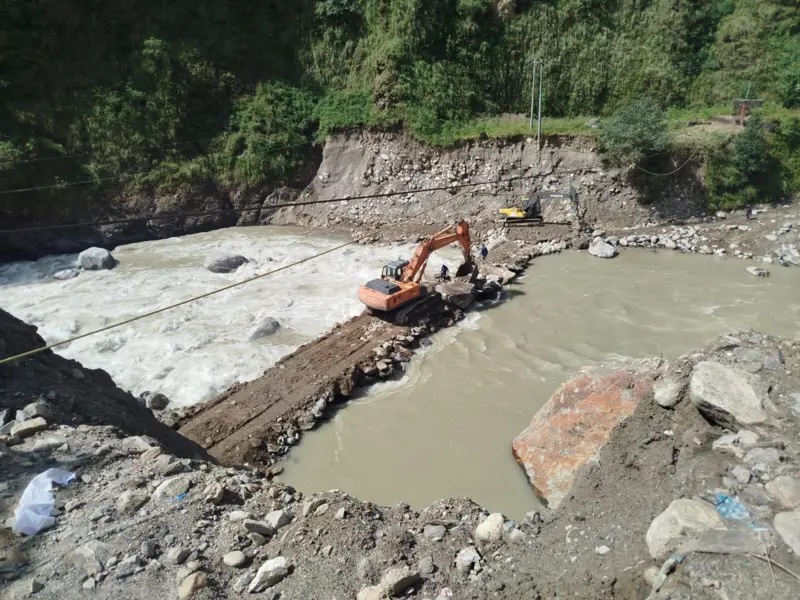Chinese Strategic Control and Poor Infrastructure at Tatopani and Rasuwagadhi: Planned Delay or Incompetence?

In recent years, the roads and infrastructure connecting Nepal and China through key border points such as Tatopani and Rasuwagadhi have been hit hard by natural disasters, revealing deep flaws in construction quality and project management on the Chinese side. The recent floods and landslides in 2024 have once again halted operations at these border points, highlighting ongoing concerns about China's intentions in controlling these critical points of entry. With construction work often falling short of international standards, questions are now being raised about whether the delays are simply the result of poor construction or part of a broader strategic move by China to exert greater control over Nepal's economic lifeline.
The Strategic Importance of Tatopani and Rasuwagadhi
Tatopani and Rasuwagadhi are Nepal's two key border points for trade with China. Strategically positioned, these border points link Nepal with the Tibetan region of China, making them crucial for bilateral trade. Historically, Tatopani has been the more prominent of the two. However, after the 2015 earthquake, which caused significant damage to the infrastructure, Rasuwagadhi emerged as an alternative, while Tatopani remained closed for almost four years.
The significance of these border points goes beyond economic factors. For China, these points are vital for controlling the flow of goods and maintaining leverage over Nepal’s trade routes. It is no secret that China views Nepal as an important partner in its Belt and Road Initiative (BRI), aiming to establish deeper economic and political ties with South Asia.
The Construction Agreements: Poor Planning or Strategic Delay?
The roads and infrastructure projects along these borders have been built primarily through government-to-government (G2G) agreements between Nepal and China. In most cases, Chinese state-owned enterprises such as China Road and Bridge Corporation (CRBC) and China Railway Construction Corporation (CRCC) were awarded the contracts. These companies have a history of building roads, bridges, and tunnels in Nepal under Chinese financial aid or concessional loans.
The problem, however, has not been limited to the quality of construction alone. Observers have long noted a pattern in Chinese infrastructure projects in developing countries, where delays are frequent, quality is compromised, and local economies bear the brunt of the inefficiency. There is growing suspicion that these delays are not just coincidental, but a calculated effort by China to maintain control over strategically important infrastructure. By slowing down reconstruction and rehabilitation, especially after natural disasters, China effectively deepens Nepal’s dependency on its trade routes and financial aid.
The 2024 Floods: A Catastrophe Worsened by Poor Construction
In 2024, devastating floods and landslides hit the border areas, causing severe damage to roads and bridges on both sides. At Tatopani, the Bhotekoshi River swelled, washing away the Belibridge and destroying the Lipingkhola Bridge, effectively cutting off Nepal's access to the Tatopani border. Meanwhile, at Rasuwagadhi, the road leading to the Kerung border point was swept away, leaving Nepal’s trade with China completely paralyzed. Despite immediate promises of rehabilitation from Chinese authorities, weeks have passed with little visible progress.
One of the main criticisms emerging from Nepal’s side is the poor quality of the construction. Reports indicate that the infrastructure, built under Chinese contracts, was not designed to withstand Nepal’s monsoon-driven landslides or the intense flooding in these regions. Instead of using robust materials and designing roads that account for the mountainous terrain and unstable land, the construction was rushed, and cheaper methods were employed. The result was predictable: a few years after the roads were completed, they began to erode, and during the 2024 monsoon season, they crumbled altogether.
Delays and Strategic Interests
The delayed response by the Chinese contractors and authorities further fuels speculation that China may be deliberately stalling. In a statement made to Nepali officials in August 2024, Chinese representatives admitted that the roads in the Kerung area had been heavily damaged, but provided no clear timeline for repairs. While natural disasters are certainly beyond anyone’s control, the pace of reconstruction seems suspiciously slow, especially given China’s reputation for rapid infrastructure development when it suits its own interests.
By delaying repairs, China maintains a firm grip on these trade routes, subtly reinforcing Nepal’s reliance on Beijing. This not only impacts trade but also puts pressure on Nepal to concede to Chinese demands on broader economic and political issues. The delays force Nepal to look for alternative routes through India, which are not only more expensive but also increase transit time significantly.
The Impact on Nepal’s Economy
The economic losses for Nepal are staggering. According to customs officials, around 1,100 containers, many of them carrying perishable goods, have been stranded at the borders since the floods. Fruit and other consumables imported for Nepal’s major festivals like Dashain and Tihar have spoiled, resulting in millions of rupees in losses for Nepali businesses. Ram Hari Karki, president of the Nepal Himalaya Cross-Border Trade Association, has been vocal about the impact of these delays on local traders. He stated that nearly 700 containers at Kerung and 400 at Tatopani have been stuck for more than a month, leading to an acute shortage of goods in the Nepali market.
Furthermore, the closure of these border points has severely impacted customs revenue. The Tatopani customs office, which has an annual revenue target of over NPR 21 billion, has seen revenue collections drop to nearly zero since the closure. The same is true for Rasuwagadhi, where the target is NPR 30 billion. The financial strain on the Nepali government is immense, as both offices are among the country’s largest sources of customs revenue.
Conclusion: A Growing Dependence
The combination of low-quality construction, strategic delays, and economic losses illustrates the deeper problems in Nepal’s trade relationship with China. While the G2G agreements were meant to strengthen ties and improve Nepal’s infrastructure, they have instead led to growing dependency and significant vulnerabilities. The low-quality infrastructure has proven disastrous during natural calamities, and China’s slow response suggests a strategic move to maintain control over Nepal’s trade routes.
As Nepal looks toward the future, it must carefully reconsider the terms of its agreements with China. While economic cooperation is important, it should not come at the cost of sovereignty and self-sufficiency.
Sharp Power



![From Kathmandu to the World: How Excel Students Are Winning Big [Admission Open]](https://nepalaaja.com/img/70194/medium/excel-college-info-eng-nep-2342.jpg)
